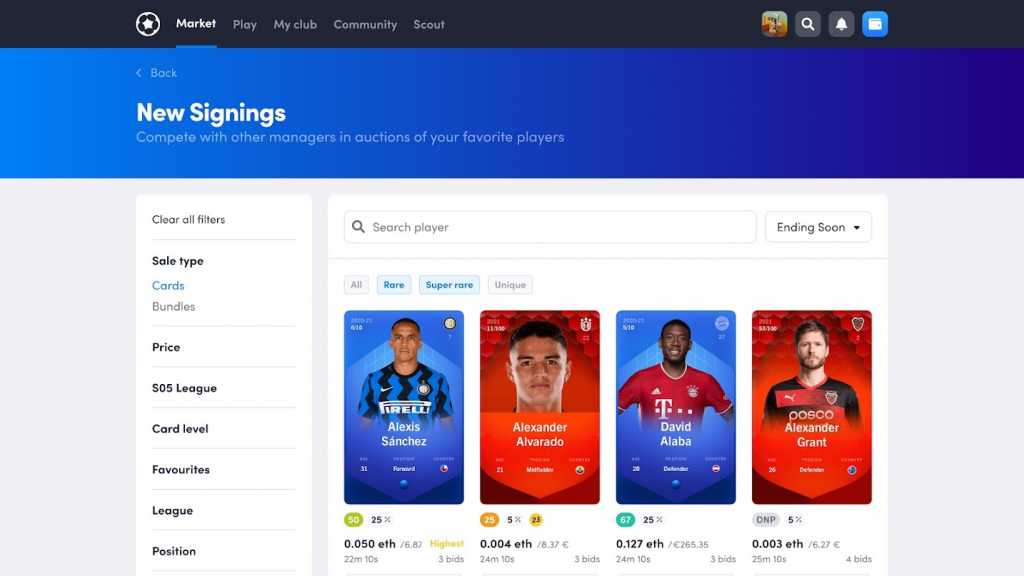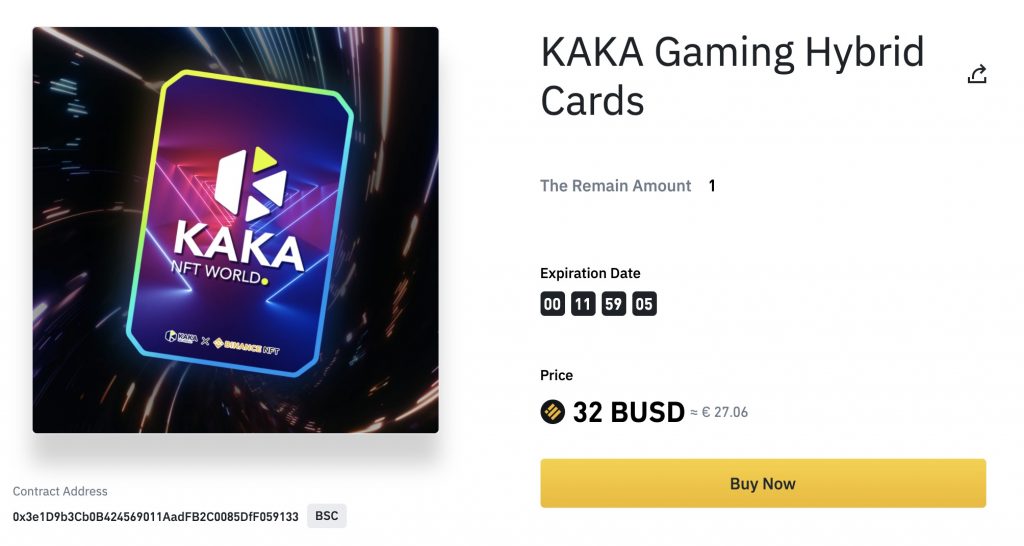NFTs are unique digital collectibles on the blockchain. This feature makes them suitable to use in games as representations as characters, consumables, and other tradeable items.
NFT games have become popular in the Game-fi world as a way to earn income. You can sell your in-game NFTs to other collectors and players and even earn tokens with play-to-earn models.
When moving your gaming NFTs, make sure you transfer them to a compatible wallet. Also, look out for common scams whenever you send the NFT to an NFT marketplace or other user. Finally, read the rules carefully of any NFT game you play to see any chance of loss.
NFT games are mainly present on Ethereum and Binance Smart Chain (BSC). Some offer a battling experience with collectible characters like CryptoBlades and Axie Infinity, and others use collectible cards like Sorare.
Binance also offers NFT Mystery Boxes, which give holders the chance to own NFTs of varying rarity. These Boxes are included in Collections partnered with NFT games.
Introduction
From their beginnings with the CryptoKitties craze, NFT games have developed and begun to offer play-to-earn models. Game-Fi, as it’s become known, mixes the worlds of finance and gaming, providing players opportunities to earn income as they play. You no longer need to only rely on winning, finding, or breeding a scarce collectible worth thousands of dollars. Players can now choose to experiment with multiple gaming models in various themes aside from collectible animals.
What are NFTs?
A Non-Fungible Token (NFT) is a digital, cryptographic token on the blockchain representing a unique item. An NFT has many use cases. It could be a digital asset in a game, a collectible piece of crypto art, or even a real-world object like real estate. NFTs have solved the long-standing issue of creating decentralized digital collectibility and ownership in a “copy-paste” world.
An NFT is non-fungible. This property means each token is unique and cannot be swapped identically for another token ever. You can trade 1 BTC (bitcoin) for another 1 BTC equal in every single way. With an NFT, this is impossible, even with NFT art released in a series with multiple versions. In this case, each NFT’s metadata will differ, just like you would have in a numbered series of prints.
How do NFT games work?
NFT games are different from just holding crypto-collectibles in your wallet. An NFT game will use NFTs in its rules, mechanisms, and player interactions. For example, a game could represent your unique character or avatar as an NFT. Digital items you find while playing the game could also be NFTs. You can then swap or trade your NFTs with other players for profit. A newer, play-to-earn model also allows you to generate income from NFT games which we’ll discuss more later.
So how do you take NFTs and technically implement them into a game environment? To swap, create, and implement NFTs within a game, developers create smart contracts that make up the rules for the NFTs used. Smart contracts are self-executing pieces of code stored on a blockchain.
CryptoKitties, for example, has a small number of main contracts that structure the game. The most famous is their geneScience contract that determines the random mechanics that generate new cats. The game developers initially kept its code secret. Interested players even created tools to analyze the odds of particular traits in cats turning up. With this information, players could optimize their chances of developing a rare breed worth more money.
What are play-to-earn NFT games?
Play-to-earn NFT games give users the chance to generate an income stream through playing. Typically, a player is rewarded with tokens and occasionally NFTs, earning more the longer they play. The tokens earned are often needed as part of the game’s crafting process.
The token method is usually the more stable of the two, as tokens can be earned steadily through play while NFT drops are more chance-based. Play-to-earn has been especially popular with users in low-income countries as an alternative or boost to fixed income or social security.
Axie Infinity has become one of the most well-known play-to-earn games. The game requires an initial investment to purchase three Axies, or you can receive a free Scholarship from another player. Once you have a Starter Team and begin completing tasks and challenges, you can earn Smooth Love Potion (SLP), an ERC-20 token tradeable on exchanges.
Breeders use SLP to breed new Axies, creating an economy for the item. Axie Infinity became particularly popular in the Philippines, where many users started to live off its play-to-earn model. Many players are making between $200 to $1000 (USD) per month, and some even more than that depending on the market price and time invested.
What are in-game NFTs?
In-game NFTs offer another way for you to generate an income through playing NFT games. Rather than earning a fungible ERC-20 token like SLP in Axie Infinity or SKILLS in CryptoBlades, you earn NFTs that represent collectible items. This gameplay mechanism is the traditional way of generating income with NFT games. Items will vary in their worth based on their cosmetics, rarity, or utility based in the game.
CryptoKitties is one example of a game that relies only on the collectibility of in-game NFTs. There is no way to keep playing and earn a steady income without the element of chance. Most newer NFT games offer a mixture of both play-to-earn and in-game NFTs.
How do NFT games make money?
The amount of money you can earn playing an NFT game will depend on the specific game’s mechanics and market demand. The money you make will come from other users who value the NFTs or cryptocurrencies earned in the game. You will need to cash out by selling your goods on a market, exchange, or auction house. With NFT games, value is derived either from the NFT or token’s collectability or in-game utility. These two factors also lead to speculation.
Can I lose money playing NFT games?
It’s possible to lose money playing NFT games. The exact amount depends on the type of game you’re playing, its mechanics, and the value of the NFTs you’re handling. Losing money doesn’t necessarily mean you’re being scammed. As NFTs are speculative and their value depends on what people place on them, your losses also depend on market forces. Like any crypto investment, only spend what you can afford to lose.
Can I lose my NFTs?
With the value some NFTs are worth, it’s a common fear to lose them while playing a game or interacting with the blockchain. Whether you’ve purchased your NFTs or earned them in-game, you need to make sure you keep them secure. In short, it’s possible to lose your NFTs if you aren’t careful. However, your chances of losing them are minimal if you follow the best practices we’ll outline later.
- There are few possible ways you might lose your NFT:
- You attempt to transfer it from your wallet to another that doesn’t support your NFT’s token standard.
- You are the victim of a scam or fraud, and you send your NFT to a scammer.
- You give a malicious smart contract permission to access your wallet, and it takes your NFT.
- You lose it as part of the rules of a game.
Apart from the last, you can avoid the situations above with some improved knowledge of NFTS, blockchain technology, and scams in general. Just like you wouldn’t use PayPal or internet banking without understanding how to use it correctly, the same goes for NFTs. To make sure you don’t lose your NFTs, you should:
- Confirm that if you are sending your NFT to another wallet, you aren’t falling for a scam. You can see the most common ones in our 5 Common Cryptocurrency Scams and How to Avoid Them guide.
- Understand the types of tokens and blockchains your wallet or platform supports. ERC-721 and ERC-1155 are the most common NFT token protocols for Ethereum, and BEP-721 and BEP-1155 are the most common for Binance Smart Chain (BSC). Always make sure you’re sending them to the correct address and never assume their compatibility.
- Only interact with smart contracts from reputable projects you can trust. If you permit a smart contract to interact with your wallet, be aware of the risk that the contract could remove your funds.
- Check carefully the rules of the game you’re playing. Some NFT games allow you to trade with other users or use NFT consumables. These could be items or potions for example. Familiarize yourself with the game to avoid any unwanted surprises.
Popular NFT games
There’s a wide range of NFT games available, with the majority on BSC and Ethereum. Some offer more traditional video game experiences, and others depend mainly on the collectibility of NFTs.
Axie Infinity
As we mentioned before, Axie Infinity follows a model similar to Pokemon with collectible creatures and battles. Axie Infinity is on the Ethereum blockchain and provides users a potential income based on trading Small Love Potions (SLP), Axies, and Axie Infinity Shards (AXS). SLP and AXS are both available to trade on Binance.
Sorare

Sorare is a fantasy football game with collectible, tradeable soccer players from real life. You create a five-player soccer team using either free cards for beginner players or purchasing tokenized cards. You can earn points to level up for every game you win, goal you score, or other events you complete.
Gods Unchained
Gods Unchained is a tradeable NFT card game on Ethereum similar to Magic The Gathering or Hearthstone. Gamers build decks with different powers and strengths to combat other players. As you win, you find in-game items to use or sell. If you win Ranked games, you can begin to earn Flux that lets you craft powerful NFT cards. You can then take your profits by selling them or reinvest in new cards and continue the process.
Binance NFT Collections

Binance NFT Marketplace provides an NFT gaming experience with NFT Mystery Boxes and Collection partnerships. These partnerships range from digital artists to NFT games. Every purchasable Mystery Box contains a random NFT of a different rarity from the Collection. You can either open the box to reveal the NFT or sell it without opening it.
NFT Collections contain several NFTs and Mystery Boxes centered around a theme or project. Some of the most popular so far have been Game-fi Mystery Box Collections. Let’s take a look at a few:
The MOBOX Collection. MOBOX is a gaming platform on BSC combining DeFi yield farming with NFTs. The Collection involves NFT Mystery boxes containing MOMO NFTs with randomized hashing power in the MOBOX platform. The more hashing power the NFT has, the more valuable the MOMO is in MOBOX’s games.
The My Neighbour Alice Collection. My Neighbour Alice is a virtual world-building game featuring NFT cosmetic items. While the game assets contained in the Collection’s Mystery Boxes are cosmetic only, users still value them and give them worth in the secondary market.
Closing thoughts
NFT gaming takes digital collectibles and creates rules for players to interact with each other’s NFTs. While some people value NFTs for their collectibility, others want them for their utility. Many NFT games work like a trading card game, but not everyone who collects the cards intends to play. Game-fi has now created new NFT gaming economies that have changed how people can earn using NFTs. To make money, it’s not just about luck and collecting anymore; it’s also about playing too.